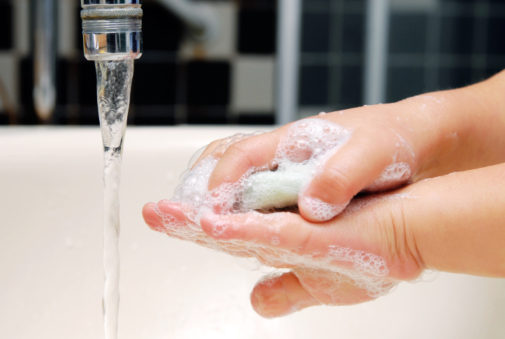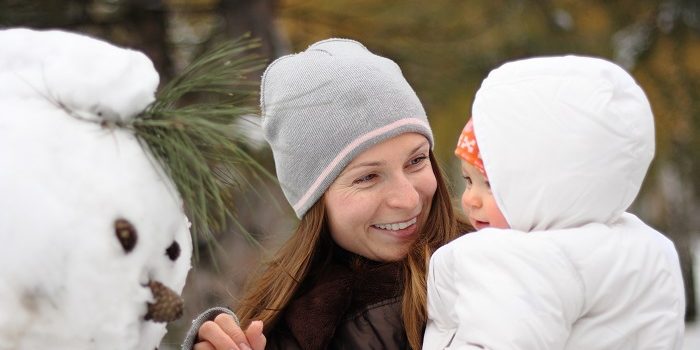Winter can seem so much worse when you’ve got a vulnerable little one to protect. Try these strategies to stave off chilly weather, guard against germs, and keep your baby healthy.
The following post was written by Stacy Whitman for Parents & American Baby.
While I was giving birth to my oldest son, Whit, the first snowflakes were falling in our ski resort town of Sun Valley, Idaho. It was late October, and we were facing many months of snow and temperatures that could freeze the nose off a bear. In some ways, it felt like the ideal time to hibernate with a new baby. But I couldn’t help worrying: Would we be locked inside all winter? How would we keep Whit warm at night? And with cold and flu season in full force, what if he got sick?
It’s true that caring for a baby in the dead of winter has challenges, but they shouldn’t force you to be stuck in the house with your sweetie. Unfortunately, we can’t send you and your bambino to Bermuda until it warms up. But to help, we did tap a team of experts to glean their smartest tips for handling four common cold-weather troubles. The forecast just got sunnier!
Winter Woe: It’s Freezing Out
Regardless of what your mom may say, it’s okay to take baby out in the cold as long as it’s not uncomfortably chilly or windy and you don’t gallivant all afternoon. Kids younger than 2 are more susceptible to hypothermia and frostbite, however, so be cautious. When in doubt, stay in, particularly if your child is under 6 months. “Young babies aren’t able to regulate their temperature well and can lose heat quickly,” warns pediatrician Jennifer Shu, M.D., coauthor of Heading Home With Your Newborn.
If you do venture out, dress your munchkin in layers. Tots 12 months and older require the same amount of clothing as you do, and younger babies need one extra layer, says Robert Bonner, M.D., a pediatrician at St. Christopher’s Hospital for Children in Philadelphia. A hat is a must, and be sure to protect your snow bunny’s fingers and toes. He’ll need waterproof boots once he’s walking.
Watch out: If his lips have turned blue, or he has a pale nose, fingertips, or ears, he might be too cold. He might be too hot if the back of his neck feels warm or sweaty, his cheeks are flushed, or he has a bumpy rash on his chest or tummy. Also beware if he starts acting fussy or lethargic.
Winter Woe: Her Skin is Dry and Itchy

Running the heat can dry out your child’s skin — the last thing she needs if, like approximately 10 percent of babies, she has eczema, says Seth Orlow, M.D., Ph.D., chairman of the Ronald O. Perelman Department of Dermatology at the New York University School of Medicine, in New York City. A few precautions can keep her complexion in the clear.
Limit baths to under ten minutes and use lukewarm water. Soap can be irritating, so instead try a mild hypoallergenic cleanser free of dyes and fragrance (such as Dove Sensitive Skin Nourishing Body Wash or Aveeno Baby Wash & Shampoo). Pat her dry with a towel, then apply a hypoallergenic lotion or cream (such as Aveeno Baby Daily Moisture Lotion or Mustela Hydra B?b? Body).
Before you head out, slather an unscented emollient (like Aquaphor Baby Healing Ointment or Vaseline Petroleum Jelly) on her face and lips to protect her from harsh winds. If her skin still looks red or remains dry despite your efforts, check with your pediatrician, who might recommend a prescription treatment such as a topical barrier enhancer (EpiCeram, perhaps) or cortisone cream.
Winter Woe: He’s Cold in His Crib
Loose blankets increase the risk of Sudden Infant Death Syndrome (SIDS), which means that moms in northern latitudes are challenged with how to keep their sleeping babies toasty. First, dress your tot in a warm all-in-one and light cotton cap. Then, swaddle him tightly in a light blanket or use a sleep sack (it’s like a sleeping bag with armholes).
It’s best to keep the nursery at a temperature that’s comfortable for a lightly clothed adult. This may require leaving your thermostat a smidge higher than usual at night. What about simply using a space heater? Stephen Hersey, M.D., staff physician in the section of ambulatory pediatrics at Nationwide Children’s Hospital in Columbus, Ohio, warns against it. “The heater could tip over and the room could go up in flames, or the baby could touch it and end up with serious burns.” Better to caulk or weather-strip windows or add insulating curtains or shades.
Don’t overcompensate and crank up the temp too high or put him in too many layers — being overheated ups the risk for SIDS. Check on your baby once he’s asleep: If he’s sweaty, flushed, or breathing rapidly, turn down the heat or remove his swaddle or cap.
Winter Woe: Germs are Everywhere

Winter is prime time for viruses — and with her immature immune system, your baby is basically a sitting duck. Aside from staying up-to-date on vaccinations, the best way to protect her is to limit her exposure. Thoroughly and frequently scrub your hands with soap for 20 seconds under warm running water, then rinse well. In a pinch, you can also use an alcohol-based hand sanitizer (look for one that’s 60 to 95 percent isopropanol or ethanol), but it’s not quite as effective as washing. Sanitizer can be toxic, so don’t use it on your tot’s hands and keep it out of reach.
Because public places are rife with viruses, keep your infant close to home, if possible, during her first eight weeks, when she’s most vulnerable. “If you need to run to the store or can’t bear to miss your friend’s holiday party, stay at least 6 feet away from anyone who has cold symptoms,” Dr. Shu advises. Think twice before letting acquaintances touch your sweetie, but if they must, ask them to wash their hands first.
Another way to ward off bugs: “Continue breastfeeding as long as possible,” Dr. Hersey says. Breast milk supplies your child with antibodies that can help her fight illnesses.
Winter babies do require extra cautions, but remember the upside: You have the perfect excuse to stay home, a new little someone to snuggle as the snow drifts down — and months to tone up before swimsuit season.
Worth a Shot
For tots younger than 5, the flu isn’t only an inconvenience; it can lead to serious complications such as pneumonia that could land your baby in the hospital. That’s why a flu vaccine, which can prevent 66 percent of infections in young children, is an absolute must for kids 6 months of age and older, the Centers for Disease Control and Prevention (CDC) says. Because an infant younger than 6 months is too young for the shot, anyone who will be in close contact with him (including parents, grandparents, siblings, and caregivers) should be certain to get one. “The idea is to create ‘herd immunity’ so everyone around your baby is protected, which, in turn, shields your child, says CDC spokesperson Jeff Dimond. This year’s shot guards against H1N1 and two seasonal viruses (influenza A and B). If it’s your child’s first flu shot, he’ll need two doses at least four weeks apart to be fully protected.
Baby’s Sick
How to tell if your kiddo has caught a cold or the flu — and what you can do to help her feel better.
When your infant starts sneezing, coughing, refusing food, or acting seriously fussy, take her temperature (preferably rectally — sorry!). If she’s under 3 months and has a fever of 100.4?F or higher, see a doctor ASAP to rule out a bacterial infection or other serious issue, says Jennifer Shu, M.D. Call your pediatrician if your 3- to 6-month-old has a temp of 101?F, or if she’s over 6 months and has a fever of 102?F. Whatever her age, always check in with a doc if she has trouble breathing or is extremely irritable, sleepy, or lethargic.
Cold and flu symptoms are often similar. With a cold, she may sneeze, have a runny or stuffy nose, a dry cough, or a slight fever. Signs of the flu tend to be more severe and can include a moderate to high fever, headache, chills, sore throat, cough, runny nose, muscle aches, and vomiting. Suspect she has the flu? Take her to the doctor, who may give her a rapid flu test, and, if she’s very sick or at risk for complications, prescribe an antiviral medicine like Tamiflu to lessen the illness’s length or severity.
To help your tot feel better, you can use an over-the-counter fever reducer such as infant acetaminophen or — provided she’s older than 6 months and isn’t vomiting — infant ibuprofen. You probably took cold and cough meds as a kid, but they aren’t effective for young children and could have dangerous side effects, so don’t use them.
Clear a stuffy nose with saline drops and a nasal suction bulb, advises Robert Bonner, M.D. A cool-mist humidifier can loosen mucus and ease her cough too. Or run a hot shower and sit in the steamy bathroom with your tiny patient. Another trick that can relieve chest congestion: Lay her facedown on your lap, and gently tap her back with the cupped palm of your hand.
Germ Patrol
Feel awkward asking friends to wash their hands? Try these tips from experienced moms:
“When I brought my baby, Willoughby, to dinner with friends, I dramatically took a gigantic bottle of hand sanitizer out of my bag and put it on the table with a clunk. They got the joke, smiled, and helped themselves.” Heidi K. Eklund; Poughkeepsie, New York
“I always felt embarrassed asking people to wash up before holding Hayes. So I blamed it on our pediatrician. I figured my request held more weight coming from an authority figure, and I didn’t have to look overprotective.” Linley Fraser; Hailey, Idaho
“When Brody first came home, I posted a sign saying, ‘My baby is a germophobe!’ on our front door. Later, I propped the sign up on a bottle of hand sanitizer (subtle, I know!). It works and usually gets a laugh.” Kim Kempinski; Phoenix, Arizona
“A few years ago, at a convention, a stranger approached Zach’s stroller and put her finger in his mouth. I was horrified! From then on, I started carrying my son in a sling to shield him.” Angela Hoy; Bangor, Maine
Originally published in the December 2010 issue of American Baby magazine.
All content on this Web site, including medical opinion and any other health-related information, is for informational purposes only and should not be considered to be a specific diagnosis or treatment plan for any individual situation. Use of this site and the information contained herein does not create a doctor-patient relationship. Always seek the direct advice of your own doctor in connection with any questions or issues you may have regarding your own health or the health of others.

